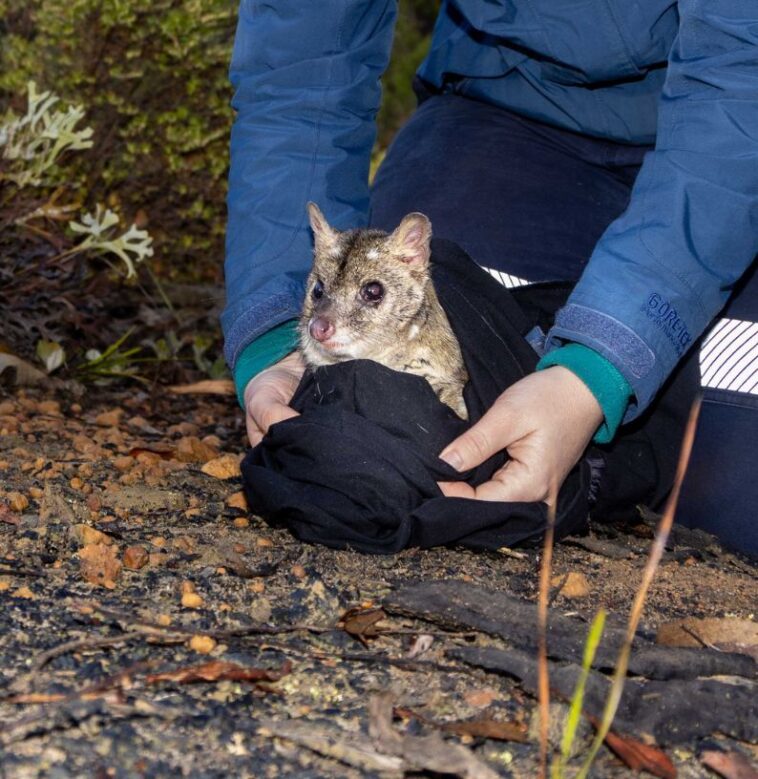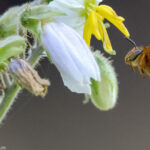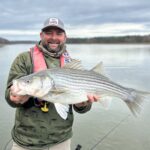Australian Wildlife Conservancy (AWC) has reached a milestone in a decade-long, ambitious Mammal Restoration Project at Mt Gibson Wildlife Sanctuary on Badimia country in Western Australia’s Wheatbelt.
A sixth and final cohort of the threatened Chuditch (Western Quoll) was recently released at the sanctuary, marking the last planned translocation on an ambitious reintroduction program which aimed to return 10 locally-extinct native mammal species back to the Wheatbelt.
Judy Moosmueller/AWC
“It is incredibly exciting to reach this significant milestone,” said Dr Amanda Bourne, AWC Regional Ecologist. “This final release of Chuditch at Mt Gibson is the culmination of nearly 15 years of planning, preparation and conservation translocations in what has become an extremely impactful million dollar a year conservation program.”
“While phase one of the Mt Gibson Mammal Restoration Project may be complete, we still have a significant amount of work ahead of us including monitoring the populations as they grow and continuing to invest in wildlife restoration beyond the feral predator-free fenced area.”

Jane Palmer, Wayne Lawler/AWC
The Mt Gibson Mammal Restoration Project commenced in 2015 with the construction of the 7,838-hectare feral-free fenced area, the largest cat and fox-free area on mainland Western Australia.
Shortly after the area was cleared of introduced predators, wildlife reintroductions began with the return of the Greater Bilby, Numbat, Greater Stick-nest Rat and Brush-tailed Bettong between 2016-2018. The Western Barred Bandicoot, Red-tailed Phascogale, Banded Hare-wallaby and Shark Bay Mouse followed between 2017-2019. In 2021, the Brushtail Possum was the first species to be reintroduced outside the feral predator-free fenced area and was joined shortly after by the Chuditch.

Louis O’Neill/AWC
Eight of the ten species reintroduced have gone on to establish healthy and growing populations. AWC will make a further attempt to establish Shark Bay Mouse, one of the two species reintroductions that did not result in large new populations at Mt Gibson, in coming years.
The final group of 12 Chuditch were translocated to Mt Gibson from Taronga Western Plains Zoo in Dubbo, NSW where they were part of Taronga Conservation Society Australia’s successful Chuditch captive breeding and ex-situ conservation program. The cohort had a three-night stopover at Native Animal Rescue in Malaga, where AWC ecologists captured images of each quoll’s unique spot pattern to develop a recognition system that can be used to identify and monitor individuals on the sanctuary.

Louis O’Neill/AWC
Upon arrival at Mt Gibson, eight individuals were fitted with VHF radio tracking collars which will be tracked using a drone with an advanced radio-telemetry system developed by Wildlife Drones. The quolls were then released on the 131,800-hectares conservation site.
“It’s really special,” said Darryl Fogarty, Badimia Elder. “Our old people would have walked with Chuditch so it’s good to see them back again. It means a lot to have them out here again.”
“What an amazing experience to help Australian Wildlife Conservancy staff to release the quoll onto Badimia barna,” said Beverley Slater, Badimia Secretary. “Thank you for the wonderful opportunity given to me and my family who will now want to keep track of these beautiful little vulnerable native animals.”

Brad Leue/AWC
“Over the last 18 months, we have moved 83 quolls from five different sites around Perth, regional WA and the breeding program in NSW,” said Robin Sinclair, AWC Field Ecologist, who has been involved in every step of the Chuditch reintroduction program since the first translocation in May 2023. “I think everyone in the team has built up a little muscle from loading and off-loading the quolls and the pet carriers.”
“The previous cohorts have settled in well on the sanctuary and we have had at least eight young born on site so far,” added Dr Louis O’Neill, AWC Wildlife Ecologist. “This has only been possible because our team has been working tirelessly to minimise threats from cats and foxes giving the quolls the best chance to establish a population and thrive for generations to come.”
“Chuditch are one of the top 20 priority mammals listed under the Federal Species Strategy, and Taronga is proud to collaborate with the Australian Wildlife Conservancy on reintroduction efforts for this critical native predator,” said Taronga Wildlife Conservation Officer, Rachael Schildkraut. “Taronga’s crucial conservation breeding program commenced in Dubbo in 2022 with the aim of reintroducing the Chuditch to conservation areas where the species had become locally extinct following European settlement.”
“Since the commencement of the program, Taronga has successfully bred 72 joeys, and 58 have already been released. This wonderful achievement was made possible thanks to an expert, multi-disciplinary team and the Taronga Sanctuary which was first opened with philanthropic support in 2018 and has well and truly shown its impact as a conservation powerhouse, establishing source populations for many endangered species to be reintroduced around Australia.”
This significant project has been made possible thanks to AWC supporters and funding from South32.




GIPHY App Key not set. Please check settings